Philly Cheesesteak Pasta
Philly Cheesesteak...With Pasta

What Is Philly Cheesesteak Pasta?
Philly Cheesesteak Pasta transforms the classic sandwich into a creamy skillet pasta with shaved ribeye, sautéed veggies, and a rich cheese sauce. No bread needed.
Ingredients For Philly Cheesesteak Pasta


Produce
8 oz Baby Bella Mushrooms
1 Sweet Onion
1 Green Bell Pepper
1 Red Bell Pepper
3 Garlic Cloves
Refrigerated
¾ cup heavy cream

Grocery
2 Tbsp Worcestershire Sauce
½ cup sherry wine
1 cup beef broth
12 oz rigatoni pasta
2 tbsp Worcestershire sauce

Meat
1.5 Pound Shaved Ribeye Steak

Spices
1/2 Tsp Salt
1/2 Tsp Black Pepper
1 Tbsp Montreal Seasoning
How To Make Philly Cheesesteak Pasta
Step 1
Cook Pasta
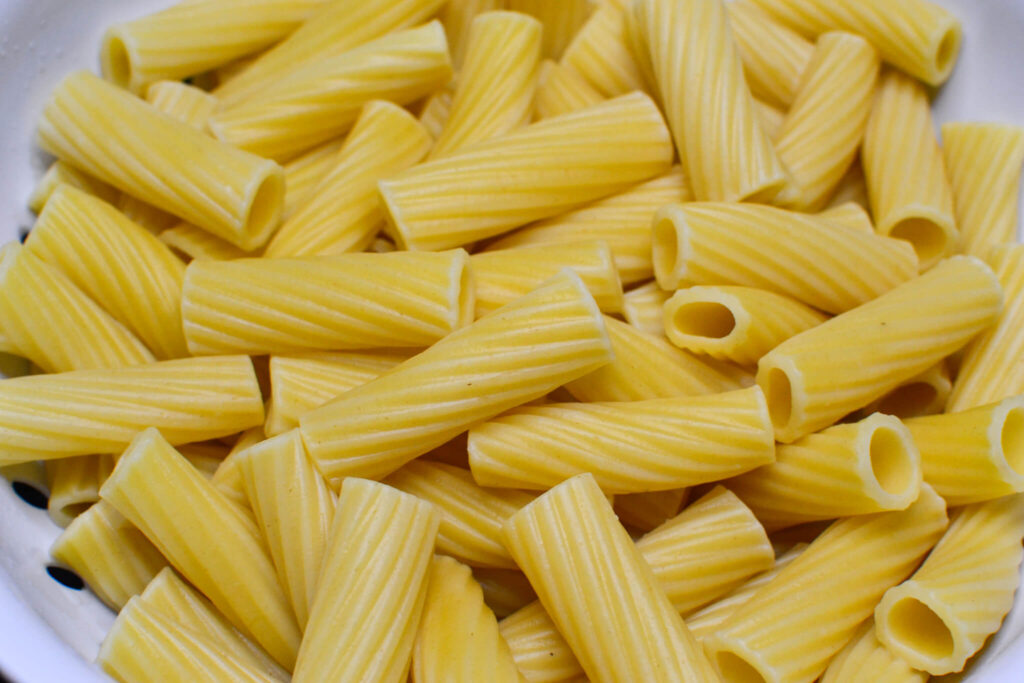
Start by bringing a large pot of salted water to a rolling boil. Rigatoni is the ideal choice here because the ridges help hold onto that rich cheese sauce. The tubular shape captures bits of steak and vegetables, giving you a more flavorful bite with each forkful. Cooking the pasta until just shy of al dente is crucial—this allows the noodles to finish cooking in the skillet without becoming mushy.
When pasta is added to a hot sauce, it continues to absorb moisture and flavor, so undercooking slightly ensures the final texture is perfect. It also prevents the pasta from breaking apart or becoming overly soft in the final dish. Once done, drain the pasta but be sure to reserve a cup of the starchy cooking water. This can be added later to loosen the sauce without diluting flavor, and helps keep the finished dish silky and cohesive.
Step 2
Cook Steak

Before adding the steak to the pan, I like to season it generously with Montreal steak seasoning, salt, and pepper. Seasoning beforehand allows the flavors to penetrate the meat slightly and ensures every bite is well-seasoned without needing to fuss with it in the pan.
Heat a large skillet or cast iron pan over medium-high heat. Add a drizzle of oil and sear the shaved ribeye in batches to avoid overcrowding—this step is essential to prevent the meat from steaming instead of browning. A crowded pan traps moisture and causes the meat to boil, which robs you of that flavorful, browned exterior.

Searing develops complex flavors through the Maillard reaction, which gives meat a deep, savory taste. It’s one of the simplest ways to elevate the flavor profile of the entire dish. Since the ribeye is shaved thin, it cooks in just a minute or two per side.
Overcooking will dry it out, so remove it from the pan as soon as it browns and set it aside to rest. This quick rest allows the juices to settle, helping the steak stay tender and juicy when folded back into the pasta.
I got my steak from my local meat shop, Hapanowicz Bros. Meat Market.
Step 3
Cook Veggies
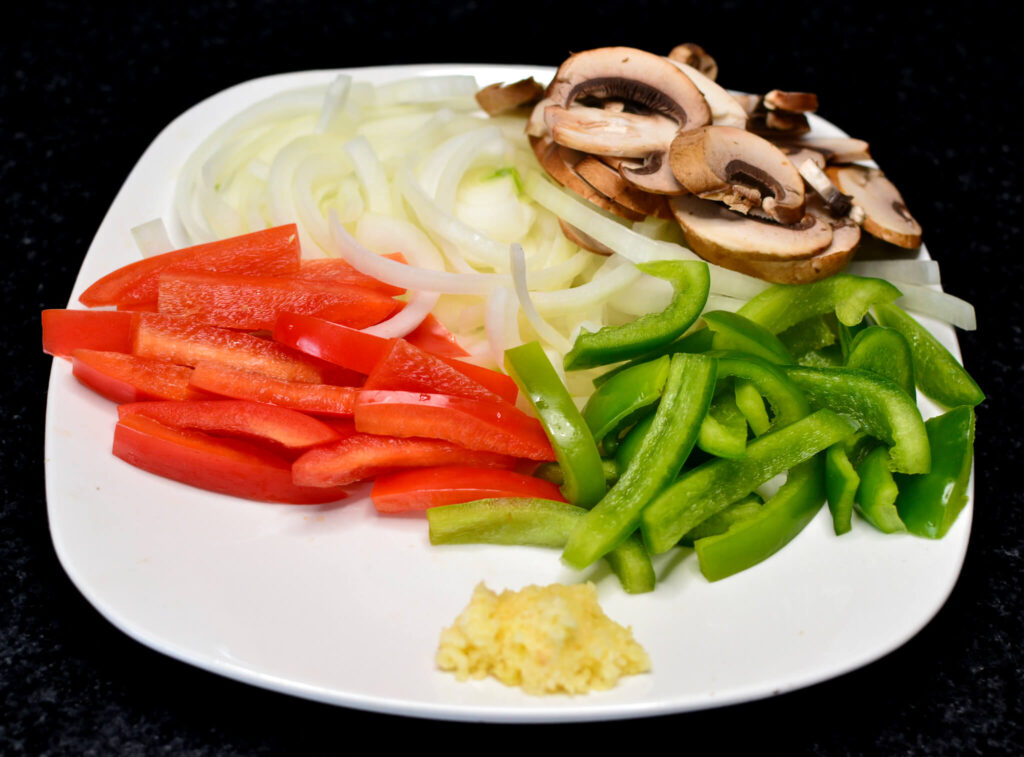
Before cooking, take time to prep your vegetables properly. Slice the onion and bell peppers into thin, uniform strips—this helps them cook evenly and blend in well with the pasta. Cut the mushrooms into small chunks so they brown nicely without becoming soggy. Mince the garlic finely so it quickly infuses the dish without overwhelming any bite. Prepping everything in advance also ensures a smooth cooking process without missing a beat.

In the same skillet, add another drizzle of oil to soak up all the beefy flavor left in the pan. Toss in the sliced onions, peppers, and chopped mushrooms—these are core ingredients in a classic Philly cheesesteak, known for adding sweetness, earthiness, and crunch that balances the richness of the beef and cheese. Cook over medium heat for 6-8 minutes, stirring occasionally, until softened and beginning to caramelize. This caramelization mimics the slightly sweet, grilled flavor of peppers and onions you’d get from a cheesesteak stand.
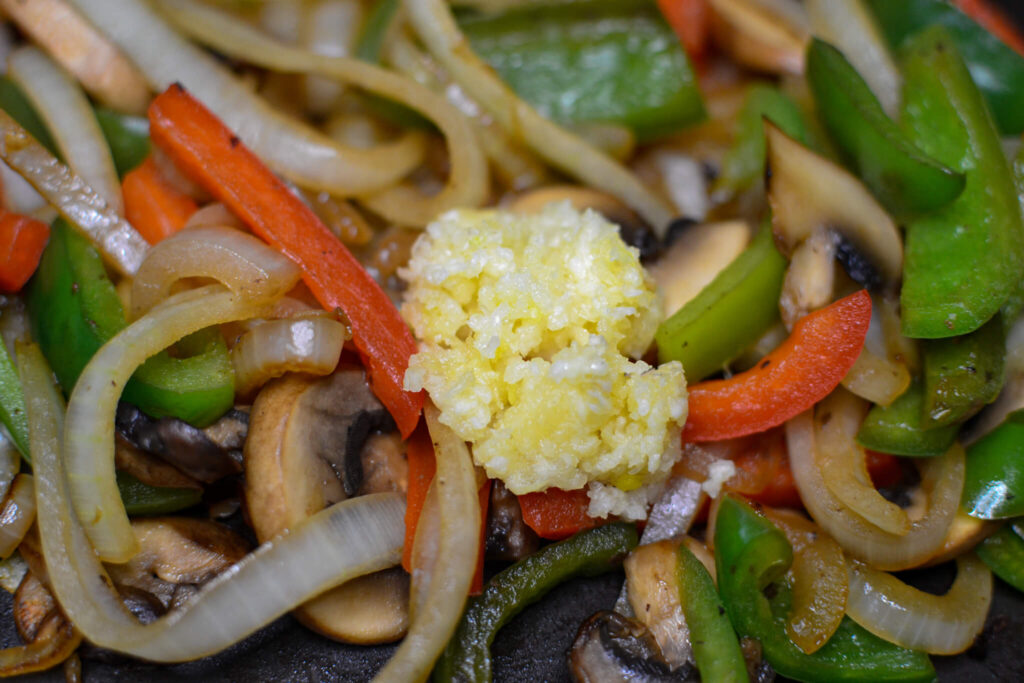
Once the vegetables are nearly tender, stir in the minced garlic. While not always found in traditional cheesesteaks, garlic enhances the savory profile of the dish. Add it at the end and cook for just a minute to release its aroma without burning it. This timing preserves its flavor and avoids bitterness.
Step 4
Make Sauce
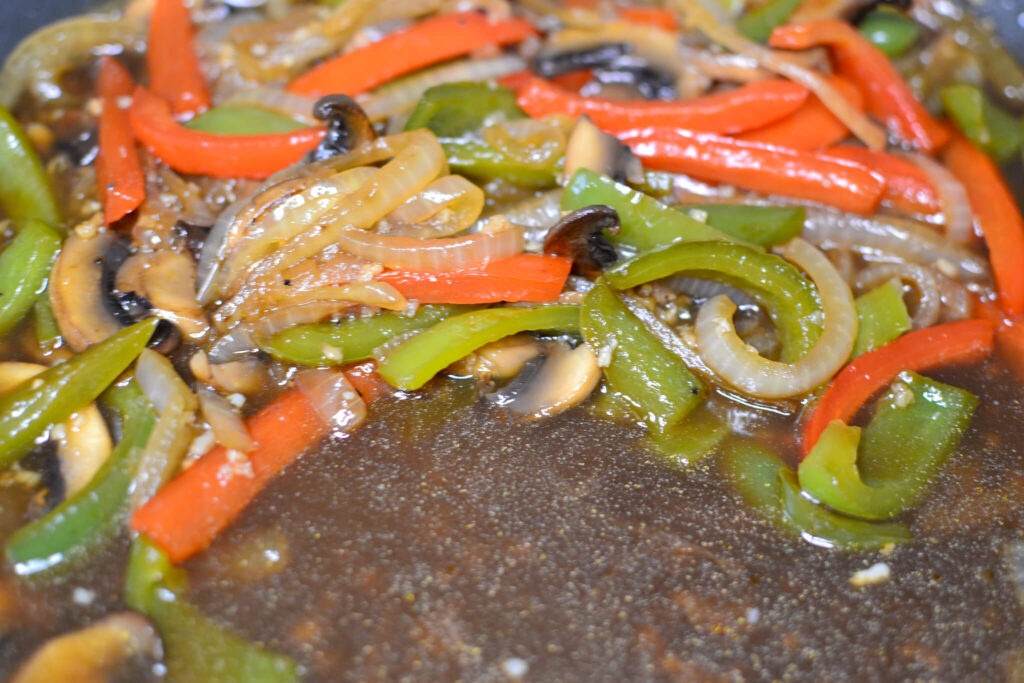
Deglazing the pan with sherry wine isn’t just for flavor—it lifts all the browned bits (fond) from the bottom of the pan, infusing the sauce with savory, concentrated flavor. Let the wine simmer for a few minutes to cook off the alcohol and deepen the taste. Use a wooden spoon to scrape along the pan and stir everything into the wine.
Then, add beef broth and Worcestershire sauce to form a rich umami base that mimics the savory depth of a traditional cheesesteak. These ingredients enhance the meaty complexity and balance out the richness of the final sauce.

Reduce the heat and begin building your creamy cheese sauce in stages. First, stir in the heavy cream and let it gently warm through—this creates a rich foundation that thins the broth slightly and adds velvety body. The cream acts as a stabilizer, helping the cheese melt evenly later.

Then add the cream cheese. It may resist melting at first but will slowly break down and emulsify into the liquid, contributing a silky, tangy layer that thickens the sauce. Keep stirring until the mixture becomes uniform and smooth.
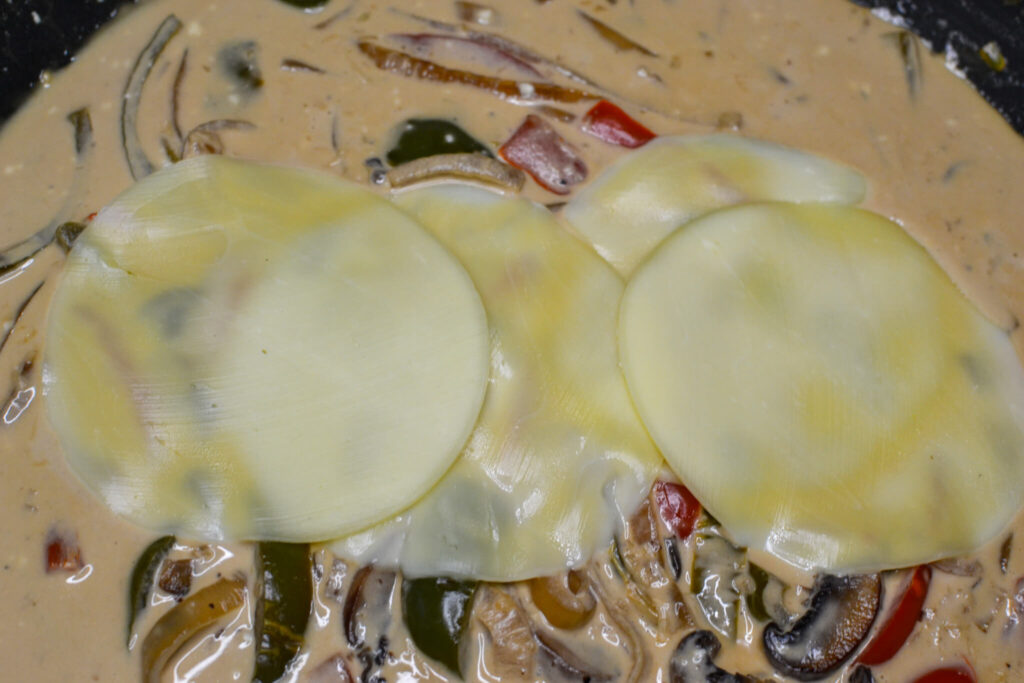
Next, tear in the provolone slices. This cheese melts smoothly and brings that distinct Philly cheesesteak flavor into the mix. Stir until the provolone fully blends into the sauce.
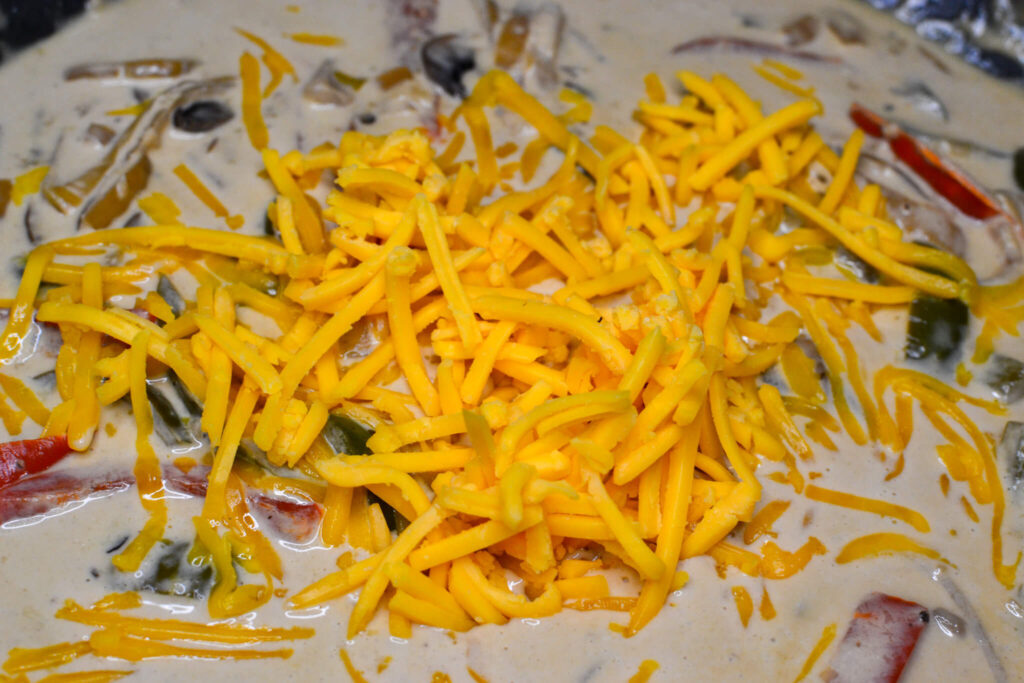
Finally, fold in the sharp cheddar. Its bolder bite helps balance the creaminess with more pronounced cheesy flavor. The blend of cheeses provides depth and richness without overwhelming the other ingredients.
At this point, taste the sauce and season with salt and pepper as needed. The result is a deeply savory, creamy, and layered cheese sauce ready to coat your steak and pasta. Take a moment to appreciate the aroma—it should smell tangy, buttery, and meaty all at once.
Step 5
Combine & Enjoy Your Philly Cheesesteak Pasta!

Return the cooked steak to the pan and fold it into the sauce with the vegetables. This step is about unifying all the major components of the dish. Let the steak gently reheat in the sauce—don’t let it cook further, as it can toughen. Reheating it in the creamy sauce helps the meat absorb some of the rich flavors and blend seamlessly with the vegetables.

Once everything is warm, add the cooked rigatoni.
Make sure the pasta is fully coated in the cheese sauce so every bite captures the full experience. The rigatoni’s hollow center and ridged surface are perfect for clinging to thick, cheesy sauces. This texture combo allows each mouthful to offer both creamy richness and bursts of meaty, savory flavor. If the sauce thickened too much, splash in some of that reserved pasta water a little at a time. The starchy water helps emulsify the sauce, keeping it glossy and silky instead of clumpy, and extends the sauce without watering it down.

This dish is finished right on the stovetop without the need for baking or broiling. While traditional Philly Cheesesteak casseroles or pasta bakes often involve a melted provolone topping, this version keeps things simple and stovetop-friendly. If you’re used to seeing a golden, bubbly cheese layer on top of similar recipes, don’t worry—this one doesn’t lose any flavor or richness. The thick, creamy cheese sauce already delivers that indulgent bite in every forkful.
Because I didn’t top the skillet with provolone, all the cheesy goodness remains within the sauce itself. The result is a more integrated, cohesive dish with no need to transfer anything to the oven. If you want a gooier bite or stretchier cheese pull, you can absolutely melt additional provolone into the sauce or layer some onto individual servings.
If your pasta soaks up too much sauce, consider making a second batch in a separate saucepan for extra richness. Simply repeat the same cheese sauce steps using smaller quantities of cream, broth, cream cheese, provolone, and sharp cheddar. Warm the ingredients over medium-low heat until smooth and creamy, then ladle it over individual servings to double down on the cheesesteak flavor.

Finally, garnish with chopped fresh parsley. It adds a bright pop of color and a fresh contrast that lightens the richness of the cheese and meat.
Enjoy!

Mare of Eastown

Inspiration
Show Setting, Philadelphia.

More About Philly Cheesesteak Pasta
The Philly Cheesesteak Legacy
The original Philly cheesesteak has been around since the 1930s, reportedly first created by hot dog vendor Pat Olivieri. Over time, it evolved into one of America’s most beloved sandwiches. While it’s typically served on a long roll with melted cheese and thin-sliced beef, today’s variations show just how adaptable it is.
Turning it into pasta isn’t about disrespecting the tradition—it’s about reimagining it. This version still pays tribute to the iconic flavors, just in a more comforting, family-style format. It’s a new way to enjoy an old favorite.
Why This Dish Works
Philly Cheesesteak Pasta isn’t just a fun fusion—it’s also practical. It brings together the best parts of a cheesesteak without the heaviness of bread, and with the added comfort of pasta. Rigatoni soaks up the creamy sauce, the veggies bring balance, and the steak remains the undeniable star. It’s a dish that delivers on weeknights but feels special enough to serve to guests.
Whether you’re looking to reinvent a classic or just feed a hungry crowd, this pasta version of a Philly staple is worth the fork.

